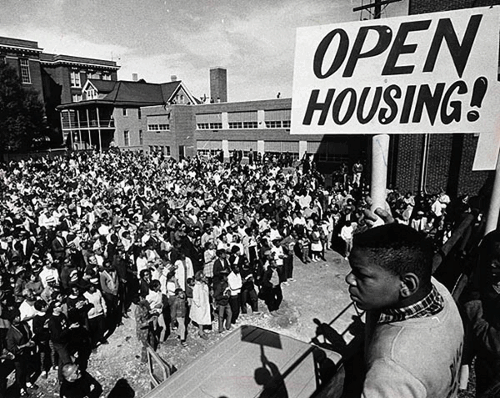In the 1960s Congress began enacting a series of civil rights laws intended to (among other things) protect certain classes of home-buyers or renters from discriminatory housing practices, and to help increase the supply and access of housing for lower income and underrepresented populations. Known as “fair housing” legislation, the laws are administered and executed by the U.S. Housing and Urban Development’s office of Fair Housing and Equal Opportunity (FHEO).
Perhaps most prominent among them is the Fair Housing Act, a part of the Civil Rights Act of 1968 that President Johnson signed exactly a week after the assassination of Martin Luther King, Jr. As amended, the act prohibits discrimination in the sale, rental and financing of dwellings (homes of any kind) based on race, color, national origin, religion, gender, familial status, or disability. Essentially this means that a landlord or home seller can’t refuse a potential renter or buyer based on these bases. Interestingly, sexual orientation or gender identity is not included in the federal law, although it considered a protected class under the California’s Fair Employment and Housing Act.
Marin County was recently found to be out of compliance with federal fair housing laws. How so?
It’s actually more an issue of what they didn’t do, and how that can actually restrict housing choices to minority classes protected under federal and state housing laws. Here’s how:
Marin recently received a large pot of federal funding as part of a Community Development Block Grant. The grants are part of a HUD program meant to help local governments provide decent affordable housing services and jobs in lower income communities. In determining how the funds would be used, Marin was required to actively solicit and incorporate input from residents of its lower income and minority communities, and HUD alleged that the county did not do enough outreach to ensure that a representative swath of the population was included in the planning process. Marin also failed to provide HUD with an adequate demographic data profile (racial, ethnic, gender, disability) on who would benefit from the funds. Put simply: their record keeping wasn't up to snuff.
Anne Quesada, the director of HUD’s regional Fair Housing and Equal Opportunity center, explains it like this: “Because they weren’t collecting or submitting accurate demographics from those getting direct benefits of the money, we couldn’t tell who was participating or benefiting from it.”
As a recipient of these funds, she adds, Marin must demonstrate that it is “affirmatively furthering fair housing” and that it has identified the “impediments to fair housing choice.” A crucial part of doing that is to demonstrate that the county isn’t just slapping up a bunch of affordable housing that's concentrated in just a few locations, the county must show that it is making proactive efforts to increase housing access throughout the jurisdiction.
